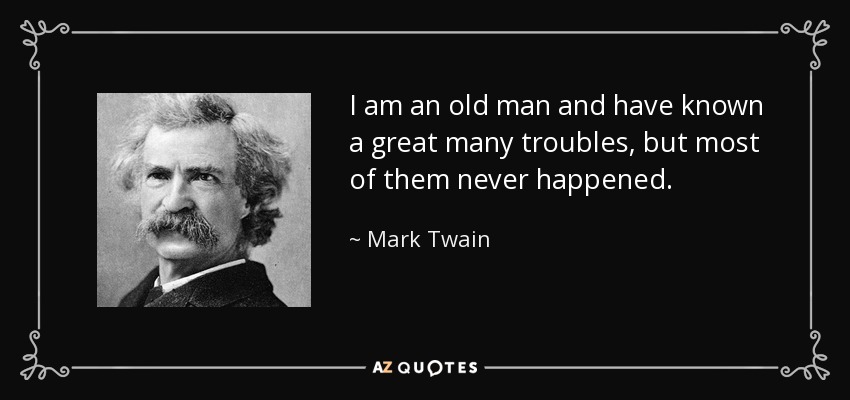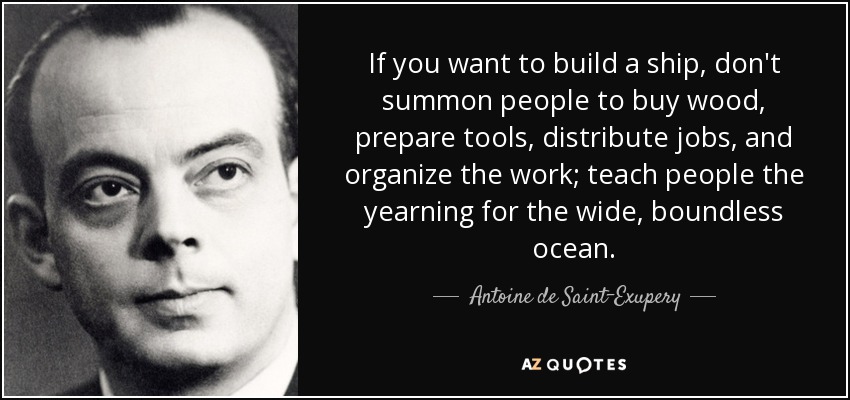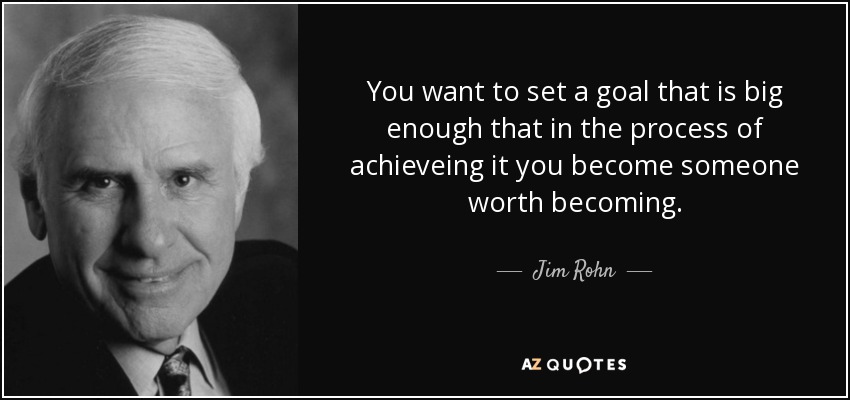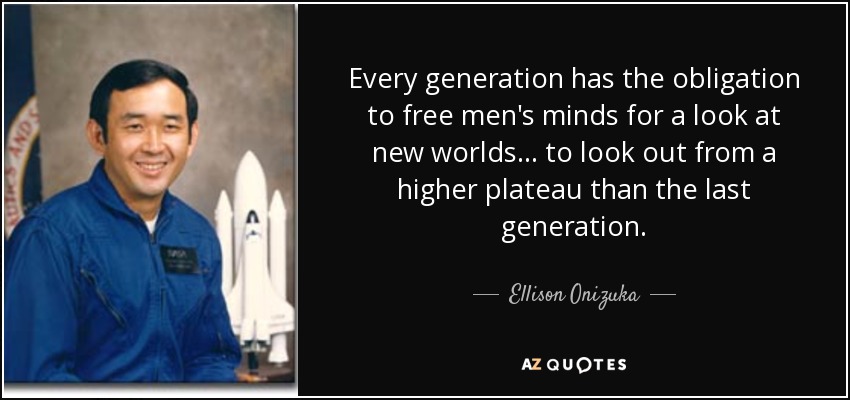Click here to return to Blog Post Intro

Setting Hefty Goals
In one of the defining speeches of the 20th Century, President Kennedy laid out the challenge loud and clear, for the whole world to hear:
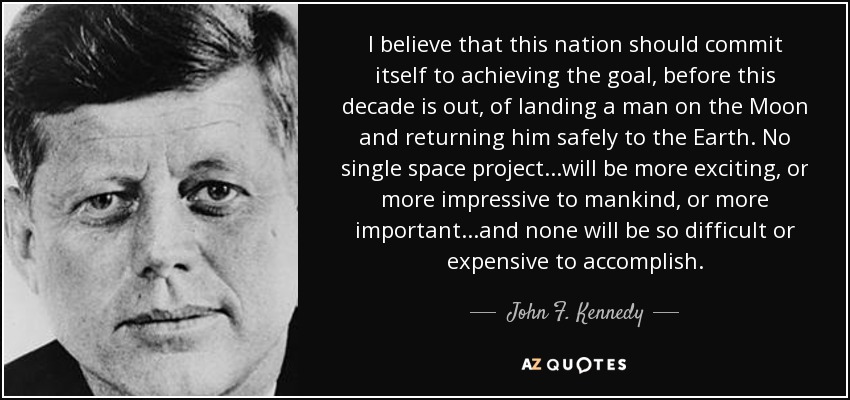
The young National Aeronautics and Space Administration (NASA) had no idea of how to send a man to the moon, much less how to bring him back safely.
So, what’s the lesson for us? Even if we cannot see the full picture or plan ahead in detailed stages, it is so important to set worthy goals. In fact, having far reaching goals in the professional and personal realm can be a multifaceted powerful catalyst for personal improvement and health.
Parker Palmer, a well-known spirituality writer, has very eloquent words to describe our modern day culture: “Our culture’s fearful obsession with results has sometimes, ironically, led us to abandon great objectives and settle for trivial and mediocre ends. The reason is simple. As long as effectiveness is the ultimate standard by which we judge our actions, we will only act towards ends we are sure we can achieve.”
Playing the game of measurable results and rewards has led us to not setting our sights high enough. And, in this respect, the Holy Grail of corporate dogma, the SMART goals, are one of the worst enemies. SMART Goals (SMART being an acronym for Specific, Measurable, Attainable, Relevant, Time-bound, amongst many other similar incarnations), are a well-intentioned attempt. What if JFK’s “Man on the Moon” goal was written as a SMART Goal?
Former German chancellor Konrad Adenauer famously said “We all live under the same sky, but we don’t all have the same horizon”.
It is almost second nature to us at this point to only set for ourselves goals that we are sure to achieve, since society places an exacerbated focus on results and celebrates winners while labeling non-achievers as losers. But JFK said, “We choose to go to the moon. We choose to go to the moon in this decade and do the other things, not because they are easy, but because they are hard, because that goal will serve to organize and measure the best of our energies and skills, because that challenge is one that we are willing to accept, one we are unwilling to postpone, and one which we intend to win, and the others, too.”
Steve Jobs never addressed his employees rallying them to cut costs, become more efficient and increase earnings. He understood magnificently that both for Apple employees and their unparalleled faithful clientele, Apple is all about beautiful products, and the firm’s objectives were to create such products, as well as challenging the status quo of competitors like Microsoft.
The moon program teaches us the importance of setting worthy goals, goals that can motivate and inspire people, even if they seem difficult to accomplish and too far reaching.
No Boundaries
Donald Williams, a two-time Space Shuttle astronaut said, “For those who have seen the Earth from space, and for the hundreds and perhaps thousands more who will, the experience most certainly changes your perspective. The things that we share in our world are far more valuable than those which divide us.”

The most striking feature of our planet observed from space is the absence of artificially created national boundaries. As the ill-fated Apollo I astronaut Roger Chaffee once put it, “Problems look mighty small from 150 miles up.”
For the sake of organization and rationalization, in everything we do we come up with divisions, boundaries, compartments that are, in essence, artificial, and only seek to better divide up reality in order to break it down into smaller, more manageable units.
Views of the Earth from space can serve as breathtaking reminders that it is a good idea to periodically step back and reassess the bigger context of things, also as a way to avoid getting submerged in an increasingly complex set of circumstances that make up reality in the 21st Century. Astronaut Sultan bin Salman Al-Saud, Space Shuttle Payload Specialist, expressed it very vividly when he related that: “The first day or so we all pointed to our countries. The third or fourth day we were pointing to our continents. By the fifth day, we were aware of only one Earth.”
It is important that, through actions, communications, events and other mechanisms, the leaders of the organization find a way for staff to see “the full Earth”, and remind them of the vision and mission of the organization, which go far beyond structures that may be ephemeral in their nature.
As leaders, how can we occasionally “go out into space” and observe this full Earth?
Crises and Opportunities
Apollo 13 has been called the most successful failure of mankind, and the resourcefulness and teamwork exhibited by controllers on Earth and the crew remains as one of the most heroic efforts in history. The Apollo 13 story is an excellent example of how crises may be used as an opportunity to motivate, strengthen and consolidate teams, as well as to how to be ready to survive a similar and unforeseen set of circumstances in any organization.
A growing body of research suggests that the greater the intensity of the adversity, the stronger the bond that is established between the participants afterward. Ancient Roman poet Horace said, “Adversity has the effect of eliciting talents, which in prosperous circumstances would have lain dormant.”
NASA implicitly and explicitly fostered personal relationships between team members. Because they shared a very discernible and nobly ambitious goal, and also as a result of spending so much time together, NASA astronauts and controllers develop very close relationships over the years. The intimate knowledge and, especially, the trust that develops as an essential component of any profound human relationship becomes particularly crucial at a time when there is no time for second thoughts, redundancy checks or second guessing.
As NASA learned, crises can become opportunities to strengthen teams, rediscover core values and do away with any of the self-imposed constraints and structures that may actually impair organizational best performance.
Preparing for a crisis involves systematic team training, evaluating and simulating future crisis scenarios and, most importantly, fomenting strong relationships amongst team members, even entering the realm of the personal, as the best way to develop collective reflexes and unwavering trust within the team.
A Real Problem
In their modern classic on Leadership, Leadership on the Line: Staying Alive through the Dangers of Leading, authors Martin Linsky and Ron Heifetz suggest that leaders can be likened to ballroom dancers, who must, indeed, spend a considerable amount of time on the dance floor, dancing the dance, but that they also have to occasionally go up to a balcony and observe the ballroom, so as to have a better perspective, see the patterns that emerge, and, in general, have a more detached view of the dancing in order to gain insight about what is really going on within the whole dance.
It is a good idea in organizations to have a “backroom”, even if on call in an emergency, and to allow leaders to have a sounding board that can come in with a better perspective of things and not be caught up physically or emotionally in the crisis. In the space business, it was taken for granted that controllers would immediately bring to the Flight Director’s attention any problems that they thought would threaten mission success or potentially become safety issues. They were expected to “Tell It Like It Is.”
Fostering a safe environment, where everybody in the organization feels free to report problems or any issues without having second thoughts about the possible consequences of that action is paramount to organizational health, and related to the core values of the organization.
Albert Einstein famously said “The significant problems we have cannot be solved at the same level of thinking with which we created them”,
Having a detached view of the situation and analyzing ongoing problems from a certain perspective are critical in properly assessing the problem. Organizations should incorporate a backroom or advisory layer in decision making to account for this important dimension in problem solving.
Dealing with Complexity
The lessons from lunar mission training are many and powerful. Even when confronted with tremendous, mind-boggling complexity, it pays off to train and run through various simulated scenarios, role playing, and even game like situations. It is not possible to anticipate everything, but it may just happen that one of the cases to be solved may present itself as is or in some other form in the future. Whenever available, role playing and simulations have the added value of providing the team with a realistic and relevant exercise that allows them to face and solve problems in a safe environment, where it is allowed to fail. The same Gene Kranz who coined the famous phrase that gave the title to his memoir on the space program “Failure is Not an Option” was the one who had to go through the good-natured ignominy of endless failures at the hands of the Simsups (Simulation Supervisors) in training.
Another powerful lesson is the value of debriefing and analyzing past processes to look for the pluses and the minuses of team performance, and, most importantly, to learn from failure and go back to the drawing board.
Intuition in the workplace is often dismissed as a byproduct of ethereal and non-rational thinking. The infinite data model and the impossibility of creating numerical analytical models of reality are gradually yielding to a more holistic approach of solving problems. The NASA controllers and the astronauts had to develop a sort of second nature to understand their spacecraft and underlying systems. NASA prepared for the unexpected by training their teams in extensive simulations sessions that dealt with multiple scenarios, from nominal events and sequences to catastrophic failures, with the objective of developing strong bonds and collective reflexes that would eventually allow them to face urgent situations and near catastrophes.
It is very important to engage in a thorough debriefing process after these activities and to learn from failure, fostering a climate that allows for honest, objective feedback about team performance with the organizational values being paramount and above brushed egos or individual accountability.
Here are a few key questions for your team or organization: Is there a mindset within the organization to learn from failed experiences and is debriefing a regular component in professional development processes? Are there barriers to an open an honest feedback culture relative to team performance?
Vision Precedes Action
When the time came to enact their commitment and support the moon program with their hard earned tax dollars, the general public were already sold on the idea of sending a man to the Moon. There was a widespread and accepted vision of space exploration being the next frontier, of the need to be first, and, essentially, to the eventually failed proposition that the Moon was just the first step to an era of unlimited space exploration. Having a powerful and inspirational vision to motivate people in the organization is not just good to have but essential, especially in today’s world.
In his wonderful book The Advantage: Why Organizational Health Trumps Everything Else in Business, Patrick M. Lencioni highlights the importance of having an inspirational vision and purpose in an organization: “An organization’s core purpose—why it exists—has to be completely idealistic. I can’t reiterate this point enough. Many leadership teams struggle with this, afraid that what they come up with will seem too grand or aspirational. Of course, that’s the whole point. Employees in every organization, and at every level, need to know that at the heart of what they do lies something grand and aspirational.”
As one of the pioneers in opening up an era exploration, Antoine de Saint Exupery expressed it with his usual clarity:
Clarity frees people to contribute in creative and diverse ways. Clear alignment around principles and purposes allows for maximum autonomy. People use their shared sense of identity to organize their unique contributions.
Visioning workshops that entail explicitly thinking out future scenarios is a great motivational tool and one that can help highlight the purpose and mission of the organization. Leaders who decry efficiency or cost reductions as their trumpet call, on the other hand, will not have many followers.
Unfortunately, the current state of affairs of the space program—with the absence of a compelling vision—is a sad realization of what happens when an organization fails to sustain a vision and build upon it.
When NASA, later in its history, embraced the “Faster, Cheaper, Better” motto for many of the unmanned missions that set out to explore the Solar System, a few of which, by the way, were outrageous failures, did not grasp that out of the three elements in the vision, only one of them (since “Faster” referred not to the actual speed of the spacecraft but rather to mission planning and execution time), could inspire people to give it their all, and it was certainly not the “Cheaper” part of the phrase.
What this generation needs is a bold vision, one that can coalesce the more elusive good will of the general public and make true on the promise of the knowledge era to genuinely align people behind a worthy goal that will challenge, motivate and inspire them to realize the enormous potential of this generation that will forever be remembered as the one that did not go to the Moon, but that went online, which is an equally significant destination. But that is another story.
It is very important to highlight the deeper core purpose of an organization in order to increase commitment from all stakeholders in the organization. High levels of alignment and fidelity are only achieved when the mission of the organization incorporates some inspirational element that will provide motivation to go beyond their regular duties.
The 21st Century lacks a vision or imperative to rediscover profound motivation to embrace the challenge of a globalized world. The generally accepted driver of the threat of outsourcing in the flat world is not a goal that will motivate a younger generation that is searching for deeper meaning.
Questions to Consider:
- Do we communicate the deeper purpose of our organization often and clearly?
- Are there spaces where people in the organization are explicitly called out to input their ideas on the future of the organization to help shape up the vision?
- Are there instances in which people in the organization are reminded periodically of the deeper meaning and the reasons for the organization to exist?
Wearing the Right Hat
It goes almost beyond saying that a culture of safety first must be prevalent in any order of business, and that leaders need to stray away from the very human impulse to choose not to address certain risks because of how cumbersome it may prove to be. The importance of creating an organizational culture that allows for people to raise their concerns freely cannot be stressed enough.
Leaders need to foster a culture where it is OK to raise the issues, where expressing concern is acceptable and has no consequence on whomever uncovers truths even if they may be hard, an environment where everybody in the organization, as we have stated before, is unafraid to call things by their name in the interest of serving the core values that must never be compromised.
NASA failed, in the eighties, to develop a culture that prioritized safety no matter what. The success of the Shuttle has made them become overconfident in dogging a bullet.
Although it would be impossible to reconstruct the collective psyche of the NASA managers, their fatal lapse of judgment may very well have been brought forth by a false aura of invincibility derived from successive layers that were ultimately isolating them from the dire reality of the dangers of space travel. It is always a good idea to perform periodical reality checks as leaders.
Leaders must be respectful of the knowledge of people on the field, and not let their judgments be clouded by pressure that is not related to the real issues to be solved.
One of the most important attributes in leadership, one that has to be constantly nurtured, especially as leaders go further up in the organizational ladder, is to still think and feel as the core member of the organization, the fundamental role that executes the essential mission of the organization itself, or that division if it were the case. Principals must think and act and feel like teachers, generals as soldiers, sales managers as salesmen, production managers as factory workers, general managers must have the uncanny ability to step into the shoes of each different role in the company, and so on. The leader’s internal compass must always be attuned and pointing in the same direction as that of their core workers, as an essential step towards never losing touch with reality, an ever-increasing danger as more and more layers are interposed in our way up the organization.
In an incredible déjà vu of management incompetency, NASA repeated the Challenger mistakes in 2003 for Columbia and, in this case, ignored requests from engineers who had reviewed launch tapes and spotted the damage, and were asking to engage the Department of Defense in providing higher resolution imagery of the Shuttle’s underbelly to assess the possibility of the damage being critical.
Once again, a special commission was appointed to investigate the accident, and the report cited that “the accident was probably not an anomalous, random event, but rather likely rooted to some degree in NASA’s history and the human space flight program’s culture.” It went on to say that NASA had “a broken safety culture”.
It is important, in any organization and regardless of the level of risk entailed in the activity, for leaders to foster a culture of openness that prioritizes the core values of the organization, making sure that all members of the team feel safe in expressing their concerns or in raising issues that are potentially serious or disruptive. It is paramount to organizational health that people in the organization are not restrained by the hierarchical culture and can speak up about any issues, and don’t feel that if they do so there will be career consequences.
Despite the many layers of complexity that an organization may have produced in its leadership and management structure, it is essential that leaders do not lose touch with reality and can still be perceptive of what goes on within the core operation of the organization, in particular on anything that relates to risks or safety.
The Inner Journey
British astronomer Fred Hoyle had written in his 1950 book The Nature of the Universe, “Once a photograph of the Earth, taken from outside, is available … a new idea as powerful as any in history will be let loose…” and, indeed, his words turned out to be prophetic. Seeing the Earth for the first time spurred a collective shift in awareness about our own planet, its problems, its overwhelming beauty and fragility and the need to preserve this unique gem which we inhabit.
Even though it may seem almost counterintuitive that the greatest lessons about our own planet were only learned when we looked at it from afar, it is, indeed, a very powerful and apt metaphor for leadership and life, and one of the most important lessons ever to be gleaned from the space program.
Ancient Chinese philosopher Lao Tzu said, “Knowing others is wisdom, knowing yourself is Enlightenment.”
The same metaphor of looking back at our own Earth can very well be applied to our organizations. Just as we need to keep a healthy eye on our own selves as we embark in our leadership journeys, it is also a good exercise to periodically recheck on how out organization is evolving, whether it is still true to its mission and vision, core values and fundamentally accepted tenets, especially at times of growth or when we are close to achieving our long-sought objectives.
Despite the focus of the space program being of exploration and the information garnered about the Moon, the planets and the solar system at large, by far the Earth was the most studied of all the planets.
We can accomplish very ambitious and challenging external goals, sometimes without pausing to reflect and look back at themselves in the process. The blind pursuit of external goals may very well lead to straying away from their own identity, a derisive and dangerous process that has led many leaders to feel emptiness while apparently at the peak of their success.
Great organizations are able to ascertain and gain profound awareness about their own identity and core values. There are many examples of organizations that lost their bearing, especially when in periods of growth, because of straying away from their identity, often through not exercising a process of reflection to gain insight as to what the organization really stands for.
Searching for New Life
The goal of searching for new life can be likened to an organization that seeks to push the boundaries of its own thinking, an organization that is challenging itself to go beyond the current accepted expectations for what is to be.
Probably one of the most abused buzzwords in business consulting, the need for organizational renewal, is stressed much and often within consultancies and advisory processes. Starting anew can be very tempting, since organizations, along their processes of growth sometimes end up creating structures and rules that are too onerous to dismantle and, in effect, it becomes more practical to start over again.
The late business philosopher Jim Rohn once said:
Leaders have a pivotal role in setting the tone and prioritizing what to emphasize in an organization, and finding a far-reaching objective is seldom seen in corporate think tanks or efforts to devise strategies for organizational success.
The search for new life can be likened to an organization that seeks to push the limits of its own thinking and embarks in a conscious process to find if there are other projects or courses of action outside of what it regularly does and that can still be conducive to realizing the mission and vision. Having a long-term objective that is not easily reachable and that can be motivating for everybody in the organization can be a great catalyst for inspiring people beyond the usual more efficiency-oriented goals.
How often does our organization consciously foster a mindset to rethink itself, to engage in a renewal process?
Our Moonshots
What happened after the Moon? Analyzing NASA’s sad downfall is, in itself, very complex. Albeit there being not a single culprit to this unhappy ending, it can be said that one of the most powerful reasons for the debacle was that, if the vision of manned exploration was to be realized, the Moon was the wrong intermediate step.
One problem was that the Moon was sold to the general public as the ultimate destination, one that would open up the gateways of space for future exploration, and that was not the case. To start with, there was a lack of a compelling objective other than the technical demonstration to go to the Moon. Once the landing was accomplished, the adventure was over and when the public turned their expectant eye to NASA to see what would come next, there was no answer. In retrospect, NASA burned its one chance to captivate the public with a goal that did not really lead to the accomplishment of the broader vision, and the agency’s subsequent struggles last to these very days, having failed to re-engage the public in anything comparable to the spirit and the passion which were the trademark features of the Apollo program.
The importance of having a clearly articulated vision cannot be stressed enough, and most leaders are aware of the need to have a compelling roadmap for the future of the organization.
Another strong learning experience that can be gleaned from Apollo is that leaders, in general, have one silver bullet to spend. So many people gave it their all because they believed in the why, in the meaning and purpose of what they were setting out to do, but there is only once chance to reclaim fanatical commitment.
In order to rally people behind a project or initiative, the real reason for going down that road, especially if we will ask our people to go beyond the call of duty, must appeal to a deep sense of purpose and, above all, have no hidden second intentions. Our figurative Moonshots must be inspiring and not merely utilitarian. As we have touched upon ion an earlier chapter, goals of higher productivity, lower costs or increased efficiency will not be enough to sustain exceptional efforts and unwavering commitment.
Go to Mars! Metaphorically speaking, in our organizations, if we want to go to Mars, we should make it a point that every one of our efforts are geared in that direction and the detours, if necessary, should serve to inspire people, get them enthused and excited, learn in the process but never losing sight of the real destination.
The real ultimate goal of the space program, as expressed in Werner on Braun’s many references to the vision for space exploration, was to go to Mars, and the Moon program, in a way, proved to be the wrong intermediate step in that after the completion of the lunar landing and meeting Kennedy’s deadline, NASA faltered in continuing to communicate a compelling vision for the future of space exploration.
It was known that the Moon offered few possibilities for significant exploration, and it was chosen as a destination mostly because of the need to beat the Soviets in the space race. The deadline set by president Kennedy added pressure to develop solutions that would meet the target.
Do we have clear what is the ultimate and definitive destination for our organization to realize its vision? What can be done in our organization to inspire a mindset of acting boldly without being reckless?
The Downfall
The most powerful leadership lesson to be delved from the space program is also the most unlikely one, and probably the hardest: what happened after the Moon landing that turned NASA from daring space adventurers to hopeless bureaucrats, In retrospect, so much effort was invested in meeting the self-imposed deadline of the end of the decade that little thought or energy was channeled into planning for the future after the Moon program. The same dazzling brilliance of the Moon landing raised the ante in a way that follow up projects failed to meet.
The International Space Station (ISS) is the living paradigm of mismanaged projects: plagued by delays and extensive redesigns, gross cost overruns forced it to become a scaled down version of the initially intended outpost. Advocates of sending humans to Mars scorned the project to no end, mocking the supposed value of the research being conducted – I once heard Dr. Zubrin, president of the Mars Society, at one of their conventions, joking with the audience, saying “Our bones are thinning out nicely, commander!”
The undeniable truth is that, surprisingly soon after the Moon landing, the general public had already lost interest in space exploration. Within an article titled provocatively “Curse You, Neil Armstrong! Did the Apollo Moon Landing Put a Dagger in the Heart of Science Fiction?”, historian and music writer Ted Gioia uses a very apt image to convey the extent of that disinterest: “Here is one measure of how quickly things changed: a decade later, when people spoke of the moonwalk, they were usually talking about Michael Jackson’s dance steps.”
There are “moon landings” in the evolution of every organization, those moments that have served to rally the good will and enthusiasm of almost everybody in the organization, and careful thought must also be given to the expected lower incentive that succeeds a landmark moment. When extraordinary efforts have been put in place towards an important goal or objective, it is paramount that leaders have a subsequent compelling follow up vision to communicate, ideally not requiring again such extraordinary and exhausting commitment.
There is truth undeniable in that NASA developed organizational cold feet over a period of more than forty years succeeding the Apollo missions. Risk can be a great silent inhibitor of creativity and innovation in an organization.
Perhaps the most tragic dimension of the NASA downfall is the prevalence of bureaucracy over common sense and the scores of people who get things done.
In the aftermath of the Columbia reentry accident, the New York Times published an article whose title almost says it all: “LOSS OF THE SHUTTLE; Bureaucrats Stifled Spirit of Adventure, NASA’s Critics Say”. The article is quite telling in how NASA gradually strayed away from its essence: “For more than three decades, NASA defied all reasonable odds as it grew into a multibillion-dollar bureaucracy with tens of thousands of managers, scientists, engineers and technicians, yet somehow remained true to the intoxicating audacity and technical mastery that gave it life.(…) Scientists said that the agency’s original sense of mission and can-do spirit had largely given way to a civil-service culture, with a maze of bureaucratic rules, overlaid by a risk-averse approach that permeated NASA after the Challenger explosion in 1986.”
Instead of heroes, NASA gives us science goals and complex stories about the search for habitability. Those goals aren’t bad, they’re just uninteresting. (..)In those exciting early days of NASA, they used to laugh in the face of risk. We want to laugh again.” Every leader should remember that, to a certain extent, the mission and the vision of the organization should serve to inspire people, to be much greater than the sum of the parts and, in a way, to be able to embody some of the virtues and values that as individuals we often cannot.
One of the hardest, and yet most important lessons to be learned from the space program is how NASA failed to build up on the success and momentum of the Moon program to truly open up the space frontier and develop missions and projects that reached further out into the solar system.
An important lesson for leaders is that an inseparable part of their role is to maintain the level of awareness of the grander objectives of the organization, to sustain a presence of the overarching vision, so that people in the organization both know that they are necessary parts in a larger context and are also able to sustain their motivation.
The prevalence of the NASA bureaucracy and multiple layers of management, as well as cumbersome processes, impeded the fast development of projects and eventually deteriorated the quality of the technical culture at NASA, as well as emptying the agency of their ability to attract and retain top talent in the field.
To a certain extent, every organization is vulnerable to their bureaucratic structures prevailing over the productive areas, and leaders should be wary of these support structures not becoming too large and consuming, excessive time, resources and efforts, as well as resulting, as in the NASA case, in prohibitive and unjustifiable overhead costs.
Questions to Consider:
- What is the nature of the risk management program in our organization?
- Do we tolerate and accept risk as an inevitable part of our business?
- How do we balance productive structures and their support structures so that they do not stifle or inhibit the primary processes?
- What is our assessment of our organizational structure?
- Are all the layers justified?
- Do we have processes in place that may hinder the creativity and productivity of people in the front lines?
- What would their opinion be if queried about the level of support and guidance of both procedures and supportive structures?
Space appeals to some of the most primeval instincts in humans: to engage in a fathomless adventure, to seek out, to go where no humans have gone before, to explore into uncharted territory.
Leaders can no longer hide behind the empty rhetoric of SMART goals or fuzzy corporate objectives. They have to believe in that higher purpose, and inescapably walk the walk and embody and model the core values of the organization.
The most important lesson for leaders from the space program is that an essential and defining part of the leadership role is to keep the dream alive, to inspire in a way that sustains motivation.
Ellison Onizuka was one of the astronauts tragically deceased aboard Challenger. He, like many others who also died in pursuing their dream, thought that the ideals he sought were worth the risks taken. His words, spoken at a graduation speech in a school in Hawaii, from where he was originally from, are even more significant in the knowledge that his death, like the other astronauts on Challenger and later Columbia, could have been prevented with the right leadership:
He went on to say, “Your vision is not limited by what your eye can see, but by what your mind can imagine. . . . Make your life count and the world will be a better place because you tried.”
In the simple and yet powerful ending of the quote lies the not to secret greatest moral imperative of leadership: if we make our own lives count, our organization will be a better place because we tried.


